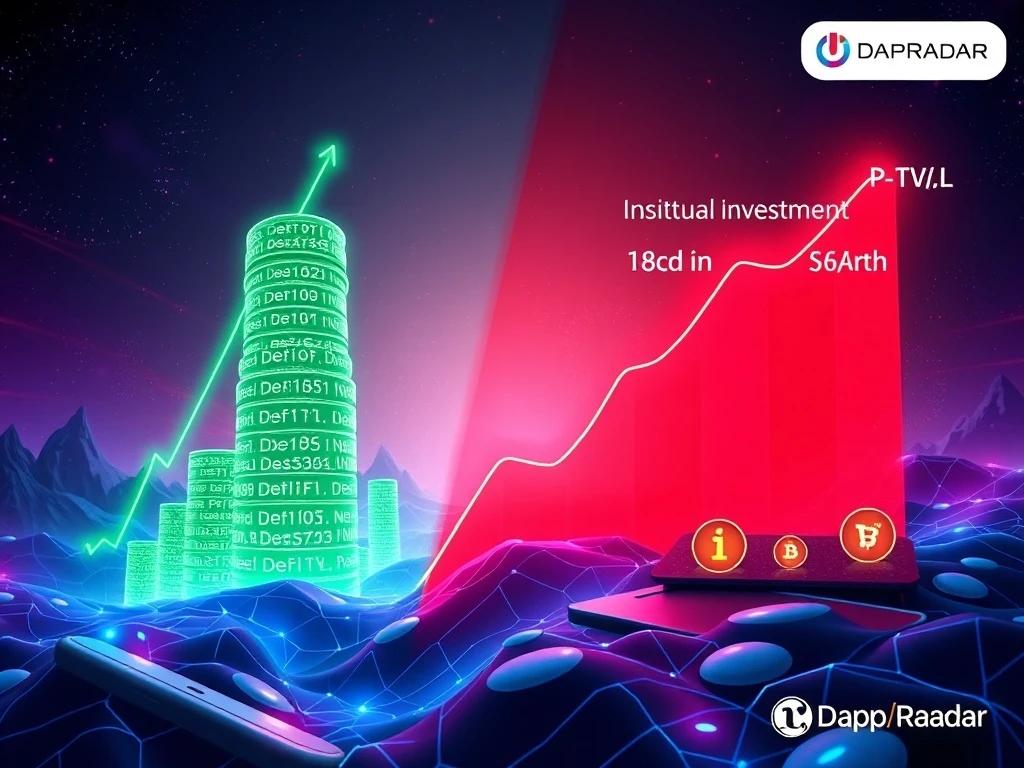DeFi TVL Explodes to Record $237B, Yet Active Wallets Plummet 22% in Q3: DappRadar

The decentralized application (DApp) industry often presents a complex picture. Recent findings from a comprehensive DappRadar report reveal a striking paradox. Decentralized Finance (DeFi) liquidity soared to unprecedented heights. Conversely, overall user activity experienced a sharp decline. This divergence demands closer examination from anyone invested in the crypto space.
DeFi TVL Reaches Astounding New Heights
The third quarter of 2025 marked a significant milestone for decentralized finance. Specifically, DeFi TVL (Total Value Locked) collectively reached an astounding $237 billion. This figure represents the highest total value ever recorded within the sector. The substantial increase indicates growing confidence and capital inflow into blockchain-based financial platforms. This record liquidity suggests a maturation of the DeFi ecosystem. It also highlights the increasing integration of digital assets into broader financial strategies.
Several factors contributed to this remarkable growth. Firstly, institutional exposure to Bitcoin (BTC) and stablecoins intensified. Major financial players increasingly recognize the value of digital assets. Secondly, regulatory clarity provided a boost. The US GENIUS Act, for instance, offered a more defined framework for digital asset operations. This clarity often encourages greater participation from traditional finance. Thirdly, new infrastructure emerged, supporting real-world asset (RWA) tokenization. This innovation bridges the gap between traditional assets and blockchain technology. Consequently, it unlocks new avenues for liquidity and investment within DeFi.
Daily Active Wallets Witness a Sharp Contraction
Despite the surging liquidity, the DApp industry faced significant headwinds in user engagement. The DappRadar report detailed a concerning trend. Daily unique active wallets averaged 18.7 million in Q3 2025. This figure represents a substantial 22.4% decrease compared to the second quarter. This decline indicates weaker retail participation across the DApp ecosystem. The drop in active users presents a stark contrast to the robust capital inflows into DeFi protocols.
The impact of this decline was not evenly distributed. DappRadar highlighted specific categories that felt the brunt of reduced activity. SocialFi and AI DApps experienced the most significant losses. AI-focused DApps saw their daily average users fall from 4.8 million in Q2 to 3.1 million in Q3. This represents a loss of over 1.7 million users. Similarly, SocialFi DApps plummeted from 3.8 million to 1.5 million active wallets in Q3. These figures underscore a shift in user interest or a saturation point in these particular DApp sectors.

Stablecoins: A Vital Bridge for DeFi Growth
Stablecoins played a pivotal role in driving the record DeFi TVL. These digital assets act as a crucial bridge between traditional finance and the volatile cryptocurrency market. They offer stability, which attracts both institutional and retail investors. DappRadar confirmed significant stablecoin inflows during Q3. These inflows reached an impressive $46 billion. Tether’s USDt (USDT) and Circle’s USDC (USDC) led this surge, demonstrating their continued dominance in the stablecoin market.
Beyond individual stablecoins, platforms dedicated to their utility also contributed to the TVL increase. Plasma serves as a prime example. This layer-1 chain, built specifically for stablecoins, debuted with over $8 billion in TVL in its inaugural month. Such innovations enhance the utility and accessibility of stablecoins within the DeFi landscape. They provide robust infrastructure for various financial operations, from lending to trading. Consequently, stablecoins solidify their position as foundational elements of the decentralized economy.

BNB Chain Emerges as a Top DeFi Performer
Network performance varied significantly across the DeFi ecosystem. Ethereum maintained its position as the leading DeFi TVL network. It held $119 billion in locked assets. However, it experienced a modest 4% decline compared to Q2. Solana, currently ranked second, saw a more substantial drop. Its DeFi TVL declined by 33% to $13.8 billion in Q3. This indicates a slowdown for some of the top established players.
In contrast, BNB Chain DeFi showed remarkable resilience and growth. As the third-largest network by TVL, it recorded a significant 15% gain in locked assets during the quarter. This surge propelled BNB Chain further into the spotlight. DappRadar attributed this increase primarily to the launch of Aster, a perpetual decentralized exchange (DEX). Aster quickly gained traction in September, attracting substantial liquidity and trading volumes. Its success underscored the dynamic nature of the DeFi market and the potential for new platforms to rapidly capture market share.

Integrity Concerns and the Future of DApp Activity
While Aster’s volumes skyrocketed, its data integrity faced scrutiny. DefiLlama, a prominent data aggregator, raised concerns. According to 0xngmi, DefiLlama co-founder, Aster’s trading volumes suspiciously mirrored Binance Perp volumes. This led DefiLlama to delist Aster from its platform. This incident highlights a growing challenge within the DeFi space: ensuring data accuracy and transparency. Such integrity issues can erode trust, a critical component for the long-term success of decentralized platforms.
The latest DappRadar report paints a nuanced picture of the DApp landscape. On one hand, institutional capital continues to flow into DeFi, pushing DeFi TVL to new records. This signifies a maturing financial infrastructure. On the other hand, the sharp drop in active wallets suggests a cooling of retail interest. This is particularly evident in emerging sectors like SocialFi and AI DApps. The industry must address this divergence. Sustained growth requires both robust capital and broad user engagement. Moving forward, the focus will likely shift towards innovations that re-engage retail users while maintaining the integrity of data and platforms. This balance is crucial for the decentralized ecosystem’s continued evolution and widespread adoption.








